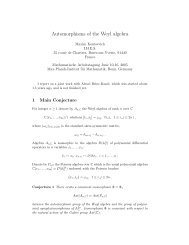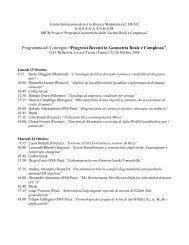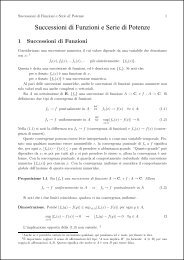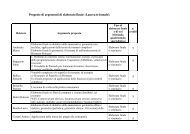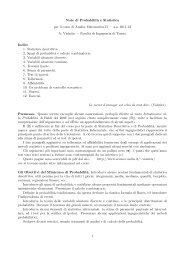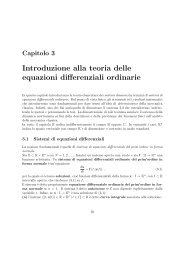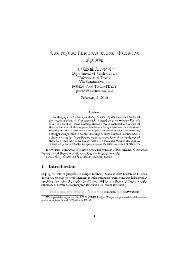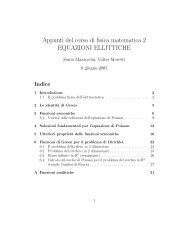Scritto del 13.7.2012 con la soluzione degli esercizi - Scienze ...
Scritto del 13.7.2012 con la soluzione degli esercizi - Scienze ...
Scritto del 13.7.2012 con la soluzione degli esercizi - Scienze ...
Create successful ePaper yourself
Turn your PDF publications into a flip-book with our unique Google optimized e-Paper software.
6<br />
il che significa f(x 2 ) < m, un assurdo.<br />
¸ Esercizio 4.<br />
Sia π : R → D <strong>la</strong> proiezione naturale. Ricordiamo che<br />
Definiamo <strong>la</strong> mappa f : R → C come<br />
π −1 ([y]) = {y + k : k ∈ Z}.<br />
f(β) = (cos 2πβ, sin 2πβ).<br />
Per costruzione f è suriettiva, poiché per ogni (x, y) ∈ C esiste α ⊂ R tale che<br />
(x, y) = (cos α, sin α). Basta prender allora β = α/2π. Si ha quindi f(R) = C.<br />
La mappa f è anche <strong>con</strong>tinua. Sia infatti A un aperto in C. Posso supporre<br />
che A sia <strong>del</strong> tipo<br />
A = {(cos α, sin α) ∈ C : α ∈ (a, b)}.<br />
Allora <strong>la</strong> <strong>con</strong>troimmagine di A è data da<br />
f −1 (A) = ⋃ k∈Z(a + 2kπ, b + 2kπ),<br />
il quale è un aperto di R.<br />
Osserviamo che f è compatibile <strong>con</strong> <strong>la</strong> re<strong>la</strong>zione di equivalenza. Infatti<br />
f(β 1 ) = f(β 2 ) ⇐⇒ cos 2πβ 1 = cos 2πβ 2 ∧ sin 2πβ 1 = sin 2πβ 2<br />
⇐⇒ ∃k ∈ Z : 2πβ 1 = 2πβ 2 + 2kπ ⇐⇒ [β 1 ] = [β 2 ].<br />
Grazie a tutto questo, f passa al quoziente e si ha dunque una mappa<br />
f : D(= R/ ∼) → C,<br />
f([β]) = (cos 2πβ, sin 2πβ)<br />
ben definita, <strong>con</strong>tinua, iniettiva e suriettiva. Per mostrare che f è un omeomorfismo,<br />
basta <strong>con</strong>trol<strong>la</strong>re che che C sia di Hausdorff e che D sia compatto. La prima è<br />
immediata in quanto C ha <strong>la</strong> topologia indotta da quel<strong>la</strong> euclidea di R 2 , il quale è<br />
Hausdorff. Per mostrare che D è compatto si può osservare che<br />
D = R/ ∼ = [0, 1)/ ∼ = [0, 1]/ ∼ ,<br />
dove <strong>la</strong> prima uguaglianza deriva dal fatto che ogni c<strong>la</strong>sse di equivalenza ammette<br />
uno e un solo rappresentante in [0, 1) (in partico<strong>la</strong>re, [x] = [x − pt(x)], dove pt(x)<br />
denota <strong>la</strong> parte intera di x) mentre <strong>la</strong> se<strong>con</strong>da uguaglianza si ottiene osservando che<br />
[1] = [0]. Poiché [0, 1] è compatto, anche D è compatto e <strong>la</strong> dimostrazione è dunque<br />
<strong>con</strong>clusa.




